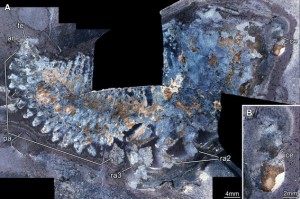A recent paper published in the BMC Evolutionary Biology journal, coauthored by former Peabody Director and Professor of Geology & Geophysics Derek Briggs, reports the discovery of the ancient arthropod Thylacares brandonensis. After unearthing the creature in Wisconsin, the research group came across a conundrum: although their fossils resembled thylacocephalans, an extinct class of crustaceans (the group that includes living crabs and lobsters), the rocks in which they were found dated from the Silurian era (around 435 million years ago), millions of years older than previous discoveries of Thylacocephala.

Under technological probing by Joachim and Carolin Haug, formerly in the Briggs lab and now in Munich, the origins of the fossil emerged from their dusty surroundings into new light. The research team used macro-lens cameras, cross-polarized lighting, Adobe Photoshop, Blender 3D modeling, and more to produce an image of the fossil that could be closely analyzed. Critical features were revealed showing that it belonged with the Thylacocephala, extended the chronological reach of the group millions of years further back. Furthermore, using detailed models alongside their own expertise, the research team was able to describe the creatures’ probable habits and lifestyle, such as how the spiny front limbs were used to capture its prey.
Every kid played in a sandbox looking for dinosaur bones, but as evidenced by the discovery of Thylacares brandonensis, paleontologists have more than shovels in their toolboxes today. 3D printers, microscopes, and manipulated light are employed alongside more traditional means to extend the scope of what can be known about ancient life on Earth.
